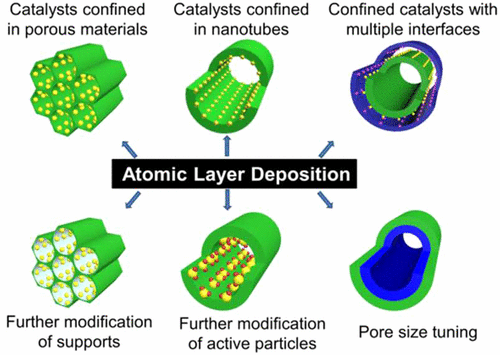当前位置:
X-MOL 学术
›
Acc. Chem. Res.
›
论文详情
Our official English website, www.x-mol.net, welcomes your
feedback! (Note: you will need to create a separate account there.)
Design and Properties of Confined Nanocatalysts by Atomic Layer Deposition
Accounts of Chemical Research ( IF 16.4 ) Pub Date : 2017-08-08 00:00:00 , DOI: 10.1021/acs.accounts.7b00266 Zhe Gao 1 , Yong Qin 1
Accounts of Chemical Research ( IF 16.4 ) Pub Date : 2017-08-08 00:00:00 , DOI: 10.1021/acs.accounts.7b00266 Zhe Gao 1 , Yong Qin 1
Affiliation

|
Governing the process and outcome of chemical reactions is the most important aim of catalytic chemistry. The confinement of active sites inside nanosized spaces provides a powerful strategy to achieve this goal. Reacting molecules (reactants, intermediates, and products of a reaction) and nanomaterials (metal/metal-oxide nanoparticles) confined inside nanoreactors have been observed to exhibit modified behaviors and properties with respect to their unconfined counterparts. Typically, catalysts confined in zeolites, mesoporous materials, metal–organic frameworks, and nanotubes are obtained by traditional liquid-phase methods. However, excess metals or undesired solvents and other reagents must be removed. It is also difficult to precisely regulate the confined nanostructures and assemble multifunctional sites in the confined nanospaces.
中文翻译:

原子层沉积约束纳米催化剂的设计与性能
控制化学反应的过程和结果是催化化学的最重要目标。纳米空间内活动位点的限制为实现该目标提供了有力的策略。已经观察到限制在纳米反应器内部的反应分子(反应物,中间体和反应产物)和纳米材料(金属/金属氧化物纳米粒子)相对于其无限制对应物表现出改进的行为和特性。通常,限制在沸石,中孔材料,金属有机骨架和纳米管中的催化剂是通过传统的液相方法获得的。但是,必须去除多余的金属或不需要的溶剂和其他试剂。精确地调节受限的纳米结构并在受限的纳米空间中组装多功能位点也是困难的。
更新日期:2017-08-08
中文翻译:

原子层沉积约束纳米催化剂的设计与性能
控制化学反应的过程和结果是催化化学的最重要目标。纳米空间内活动位点的限制为实现该目标提供了有力的策略。已经观察到限制在纳米反应器内部的反应分子(反应物,中间体和反应产物)和纳米材料(金属/金属氧化物纳米粒子)相对于其无限制对应物表现出改进的行为和特性。通常,限制在沸石,中孔材料,金属有机骨架和纳米管中的催化剂是通过传统的液相方法获得的。但是,必须去除多余的金属或不需要的溶剂和其他试剂。精确地调节受限的纳米结构并在受限的纳米空间中组装多功能位点也是困难的。











































 京公网安备 11010802027423号
京公网安备 11010802027423号